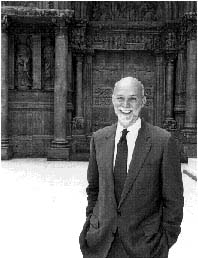 Richard Armstrong becomes Director
of Carnegie Museum of Art
Richard Armstrong becomes Director
of Carnegie Museum of Art Richard Armstrong becomes Director
of Carnegie Museum of Art
Richard Armstrong becomes Director
of Carnegie Museum of ArtFollowing an extensive national search Richard Armstrong, the chief curator of
Carnegie Museum of Art and an expert in contemporary art, was named the eighth director
of the museum. He succeeded Phillip M. Johnston and assumed his duties as the Henry
J. Heinz II Director of Carnegie Museum of Art on Friday, August 30.
Armstrong
joined the museum in 1992 as curator of contemporary art and three years later he
became chief curator, the same year in which the 52nd Carnegie International, which
he organized for the centennial year, opened to the public. In making the announcement
of the new director, president Ellsworth Brown noted the profound effect Armstrong
had already made on the collections and exhibitions, and said he expected him to become
"a particularly compelling director" of the museum because of his strong
aesthetic vision, ability to work with all sectors of the museum world, and his strong
organizational sense.
Born and educated in Kansas City, Missouri, Armstrong
studied at the University de Dijon and the Sorbonne in Paris, and received a B.A.
in Art History from Lake Forest College, Illinois. He was a Helene Rubenstein Fellow
at the Whitney Museum of American Art, and afterwards worked as a curator at La Jolla
Museum of Contemporary Art, California, and in 1980 served on the artists committee
that planned the Museum of Contemporary Art, Los Angeles. Beginning in 1981 he was
associated with the Whitney Museum again, starting as a senior instructor and rising
to curator in 1989. He co-organized four of the Whitney's well-known Biennial exhibitions,
and organized other exhibitions of contemporary art such as Richard Artschwager (1988)
and The New Sculpture 1965-7. He has served as a guest curator at the Pennsylvania
Academy of Arts and at Palacio Velasquez, Madrid, and has lectured widely and been
published in a number of periodicals.
When asked what he sees as the primary
challenge facing the Carnegie Museum of Art, Armstrong says:
"In the
four years I've been in Pittsburgh, the museum has expanded tremendously--organizing
and opening The Andy Warhol Museum and The Heinz Architectural Center, as well as
remodeling and rehanging the 47,818-square-foot Scaife Galleries. Thanks to new acquisition
funds raised through the Second Century Fund, the collection has been added to also.
Given these accomplishments, I think trustees and staff feel that we must share the
museum with even more people. The principal challenge facing us is both to widen the
audience and to deepen its experience while here. Museums may be one of the few places
left where imagination and intelligence are of comparable value. We teach, but we
must always encourage dreaming also."
--R. Jay Gangewere